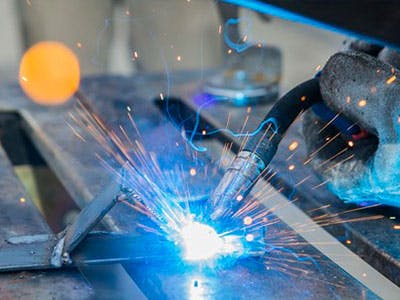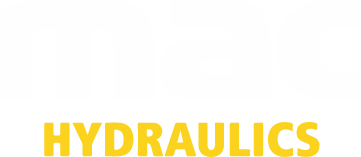Types of Welding for Hydraulic Systems
Types of Welding for Hydraulic Systems
Welding is used regularly in connection with hydraulic systems, for everything from repairing hydraulic cylinders to fabricating frames and supports. There are also a wide variety of welding processes that can be used, including arc welding, stick welding, and solid-state welding. However, there are four particular welding processes that are used the most in hydraulic repair and fabrication: MIG, TIG, stick, and friction welding. Each has its own pros and cons, as well as situations where it works best.
MIG Welding

MIG welding, which stands for metal inert gas welding, is a subdivision GMAW, or gas metal arc welding. In arc welding, an electric arc is generated between an electrode and the metal workpiece. That arc provides the localized heat generation needed to melt the workpiece metal.
In the case of MIG welding, the electrode is a bare metal wire. The welding gun continuously feeds the consumable wire electrode to keep the arc going. At the same time, it also covers the metal arc with shielding gas. The shielding gases used with MIG welding are a combination of an inert gas (argon) with an active gas (carbon dioxide or oxygen). By using this combination of shielding gases with consumable bare wire, no slag is produced.
There are several benefits to MIG welding, which also explains why it is so commonly used. It supports the ability to make multiple welding passes on the same joint and little to no post-weld cleanup. It can be used with great precision and works well even for extremely thin workpieces. In addition, the arc time with MIG welding is less than many other welding processes because it uses a continuous feed of metal wire. In fact, many welders consider it to be one of the fastest welding methods. If you need to achieve a heavy-duty weld on thick parts, MIG welding is an excellent option.
There are drawbacks to MIG welding that you need to keep in mind when considering it. The surfaces where the weld will be applied must be completely clean (free of rust, paint, or other contamination) or you run the risk of a poor weld. The process is very sensitive to breezes — even a fan can disrupt the shielding gas enough to compromise the weld. In addition to that, it requires the use of pressurized bottles of gas, making it difficult to use in the field and not very portable.
TIG Welding
TIG welding falls under the category of gas tungsten arc welding (GTAW) and stands for tungsten inert gas welding. Like MIG welding, an electric arc is induced between the electrode and the workpiece to melt the metal. What makes TIG different is the use of tungsten as the electrode material. Tungsten is used because of its extremely high melting point.
Just as with MIG welding, TIG welding also requires the use of shielding gases: argon, helium, or a mix of the two. Note that TIG welding does not require the use of a filler metal, but when fillers are used they are added to the weld pool from a separate wire or rod.
The major pro of TIG welding is that it can join nearly all metals and workpiece thicknesses. This includes thicknesses that MIG welding cannot handle. TIG welding can produce high-quality welds with no splatter and little to no post-weld cleaning. Cast and wrought iron welds are very difficult to achieve, but an experienced welder using TIG can do it. Also, it can join dissimilar metals (such as aluminum and stainless steel).
When used with steel, TIG welding can be slower and more expensive than stick welding or MIG welding. The only real exception to this rule is when creating high-quality welds using thin sections. And, even for welding similar metals, TIG welding requires careful control of the electric current used as well as pressure and timing.
Stick Welding

Stick welding, also known as shielded metal arc welding (SMAW), is another arc welding process. What makes it different is its use of a consumable filler metal rod as the electrode. This rod, called the welding stick, is coated with materials to support both flux and shielding. The bare metal end of the welding stick clamps within an electrode holder with an insulated handle. The electrode holder itself is connected to a power supply.
The equipment used with stick welding is portable and low cost, making it ideal for on-site welding operations. Unlike MIG and TIG welding, you do not need to remove paint or corrosion at the welding point. Stick welding also generates a large enough arc that wind or temperature does not affect it. Stick welding is also very flexible when it comes to where you can use it: indoors, outdoors, drafty areas, and confined spaces. This makes it ideal for on-location repairs.
The major drawback of stick welding lies in its use of a consumable rod. You will need to change out the rods during the process, which can make stick welding time-consuming. Because the length of the electrode varies during the welding process, the resistance of the rod will also vary. This, in turn, leads to variations in current that can lead to overheating and premature melting, especially when you use a new stick.
The heat involved also places a limit on how thin the metal can be (usually no thinner than 18 gauge). Finally, the generation of slag and splatter means you will need to clean the weld surface before painting or further welding.
Friction Welding
Friction welding (FRW), unlike MIG, TIG, and stick welding, is a solid-state welding process. In a solid-state welding process, a metallurgical bond is created between the two base metals — with no melting involved. Friction welding, in particular, uses frictional heat combined with pressure to achieve the bond.
In most instances, you will rotate one part relative to another while bringing them in contact via high axial forces. The relative motion under such high forces leads to friction. That friction generates enough heat to form a strong metallurgical bond between the two surfaces.
When you use rotational friction welding, your choice of workpieces is limited: at least one workpiece must be cylindrical in shape, such as a tube or pipe. On the other hand, linear friction welding uses a reciprocating motion, as opposed to a rotational motion, to generate the necessary friction and heat. The use of linear motion removes the requirements that at least one workpiece be cylindrical.
Friction welding can achieve a full interface contact, unlike TIG, MIG, or stick welding that limits contact to the welding seam. Friction welding also makes it much easier to weld dissimilar metals. Also, it also requires no flux, shielding, or filler metal and, when done correctly, produces solid welds with no porosity.
One of the drawbacks of friction welding is the inevitable flash material developed where the two parts were joined. To trim it from the final assembly, you will need to use a turning operation. The presence of flash also means that you lose some of the original length of the workpieces. You can easily estimate this loss and account for it in the design process early on.
In addition, higher quality welds achieved using frictional welding require large, powerful equipment that resembles a lathe. Because of this, the equipment for friction welding is not portable like MIG, TIG, and stick welding.
Common Welding Issues

Hydraulic components and equipment work at high pressures, which makes a solid weld critical. When your welds are not done correctly, it can be extremely dangerous. Two considerations in this context are welding defects, distortion, and residual stresses.
Welding defects can include the following:
- Incomplete fusion
- Cavities
- Cracks
- Lack of penetration (where the fusion has not reached the root of the joint)
- Lack of fusion (where fusion has not been achieved throughout the joint cross-section)
- Inclusions (where nonmetallic particles are trapped in the weld)
- Excessive spatter
- Poor weld profile
Training and experience are necessary to achieve welds that are free of these defects, and results depend heavily on the process used by the welder.
Another major concern in welding involves joining two dissimilar metals. When using MIG, TIG, or stick welding, you must consider their relative thermal conductivities and expansions to avoid distortion and residual stresses upon cooling. For example, there can be shrinkage across the weld assembly, which is especially common in butt welding (welding end-to-end). This shrinkage occurs upon cooling and can lead to warping and residual stresses. In fact, because of localized heat issues and the geometry of the welded parts, this can happen even when similar metals are used.
Professional welders know what types of measures to take to minimize the possibility of residual stresses and distortion. There are a variety of approaches, including the use of heat sinks to channel heat away, welding fixtures to retrain the movement of parts during a welding process, and stress relief heat treatment to minimize the residual stresses and eliminate distortion.
Certified welders have the knowledge and experience to select the right welding process parameters (e.g., speed, current, amount of filler metal, shielding gas) to achieve a strong weld with no welding defects.
Conclusion
Whether your hydraulic application calls for MIG, TIG, stick, or friction welding, the actual welding process is often best left to the professionals. There are many variables involved in welding that go beyond just the metals used and their thickness. In order to achieve a strong weld free of defects or an effective weld between two dissimilar metals, you need a certified, experienced welder for your hydraulic equipment.
MAC Hydraulics
At MAC Hydraulics, our certified welders take great pride in their work. They not only prepare the weld area and perform the weld, but select the most appropriate process for the project and verify the integrity of the weld through multiple, non-destructive testing methods. The experienced welders at MAC Hydraulics can handle stainless steel, carbon steel, and even cast iron for the most difficult and complex fabrications and repairs you may have. Contact us today to learn more about our welding services!

